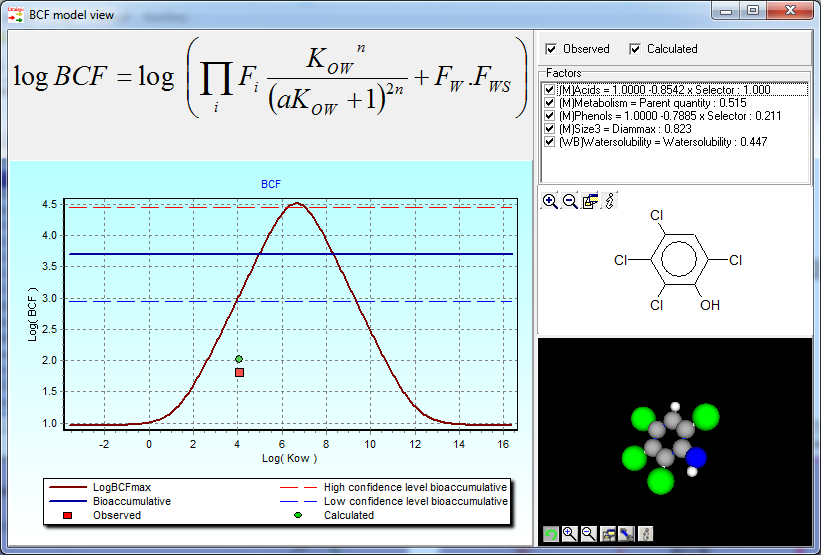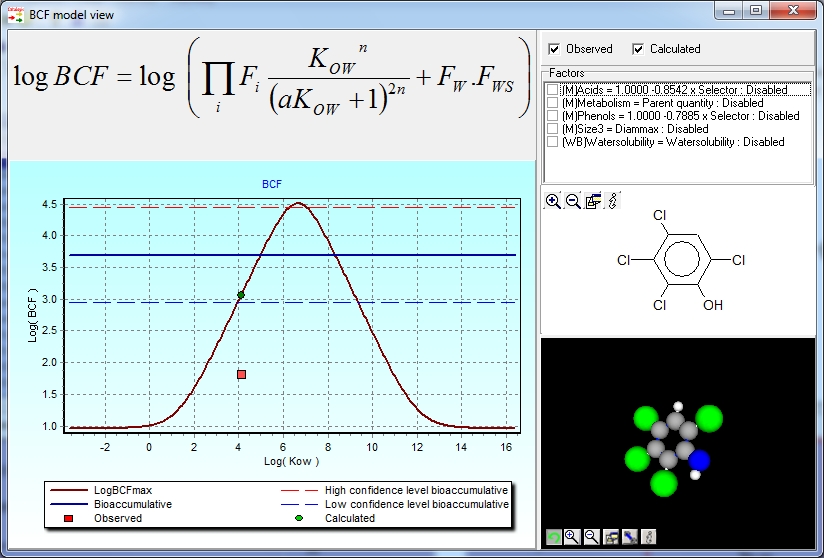BCF base-line model
Endpoint
BCF base-line modelpredicts bioconcentration factor (BCF, l/kg wet) in fish. Model accounts for a number of mitigating factors, such as molecular size, metabolism of parent chemical, water solubility and ionization.
Data
The training set of the model consists of 705 chemicals and is a compilation of three databases:
- 393 chemicals extracted from Biodegradation and Bioaccumulation Data of Existing Chemicals Based on the CSCL Japan (MITI database) [1].
- 167 chemicals tested by National Institute of Technology and Evaluation of Japan (NITE) using the same fish (Cyprinos carpio) [2].
- 145 BCF values extrapolated from dietary bioaccumulation experiments with salmonids [3].
MITI and NITE BCF data derived at the lowest concentration exposure have been used in the model development. All experimental data meet the OECD 305 protocol criteria and were generated based on the concentration of the parent chemicals only and not on the total amount of parent and metabolites (e.g., the total radioactivity).
Another training database of documented fish and rat liver transformation maps for 433 organic compounds and expert knowledge was used to determine the principal transformations and to train the system to simulate the fish liver metabolism chemicals. The documented pathways were collected from scientific papers, monographs and databases accessible over the Internet.
Model
The BCF base-line model consists of two major components: a model for predicting the maximum potential for bioaccumulation (log BCFmax) based solely on chemicals' lipophilicity and a set of mitigating factors that account for the reduction of the bioaccumulation potential of chemicals based on chemical (molecular size, ionization and water solubility) and organism (metabolism) dependent factors. Mathematical formulation of the model is:

where Kow is octanol-water partition coefficient, Fi stands for the set of mitigating factors: metabolism, molecular size, ionization, FWS is water solubility factor, Fw is the organism water content. Further details on the mathematical formalism of the model can be reviewed in [4, 5]
Domain
The stepwise approach [6] was used to define the applicability domain of the model. It consists of the following sub-domain levels:
- General parametric requirements - includes ranges of variation log KOW and MW,
- Structural domain - based on atom-centered fragments (ACFs),
- Mechanistic domain - identifies the mode of bioaccumulation of chemicals (partitioning in the organism lipids or binding to proteins).
A chemical is considered In Domain if its log KOW and MW are within the specified ranges, its ACFs are presented in the training chemicals and if the mode of bioaccumulation is driven by the lipophilicity only. The information implemented in the applicability domain is extracted from the correctly predicted training chemicals used to build the model and in this respect, the applicability domain determines practically the interpolation space of the model.
Performance
The goodness of fit evaluated by the squared coefficient of correlation is R2 = 0.85. The model correctly classified 84% of experimentally bioaccumulative and 99% of experimentally not bioaccumulative training chemicals.
Reporting
The model provides results for:
- log BCF of organic chemicals corrected with mitigating factors, (l/kg. wet),
- log BCFmax ,
- Range of variation of maximum diameter for energetically stable conformers,
- Whole body primary biotransformation half-lives (HL) for organic chemicals in fish, days,
- Metabolic biotransformation rate constant KM (d-1),
- Effect of mitigating factors,
- Applicability domain details.
References
1. Chemicals Inspection and Testing Institute, Biodegradation
and Bioaccumulation data of existing chemicals based on the CSCL
Japan, Chemical Industry Ecology-Toxicology & Information
Center, Japan, 1992, ISBN 4-98074-101-1.
2. NITE, Biodegradation and Bioconcentration of the Existing
Chemical Substances under the Chemical Substances Control Law, http://www.safe.nite.go.jp/english/db.html
3. T. Parkerton. Phase II Report. The bioaccumulation of petroleum
substances and their constituent hydrocarbons on the Canadian
Designated Substances List (DSL), Exxon Mobil Biomedical Sciences
Inc., 2004.
4. S. Dimitrov, N. Dimitrova, T. Parkerton, M. Comber, M. Bonnell,
and O. Mekenyan, SAR QSAR Environ. Res. 6, 2005,531-554.
BCF base-line model
Model features
Click the images for a larger view
logBCF
logBCFmax
Model descriptions pdf


